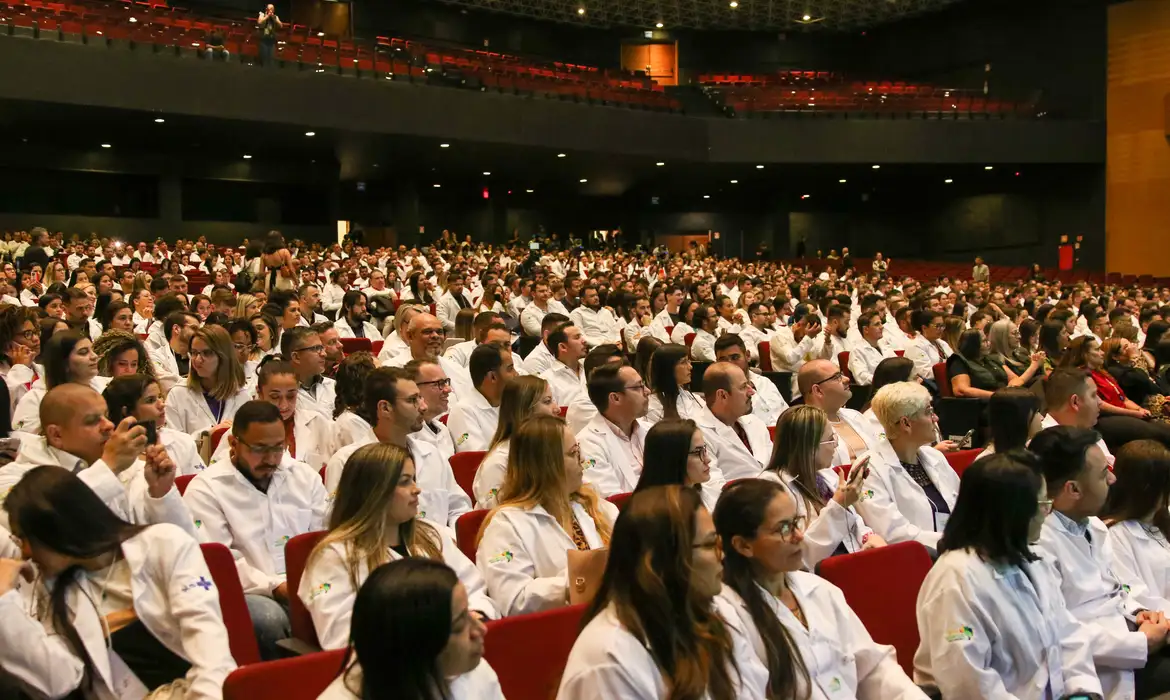
Brazil currently has 575,930 active doctors – a proportion of 2.81 professionals per thousand inhabitants, the highest ever recorded in the country. The data is part of Medical Demography 2024, released this Monday (8) by the Federal Council of Medicine (CFM).
Since the beginning of the 1990s, the number of doctors in the country has more than quadrupled, from 131,278 to the current number, registered in January 2024. In the same period, the Brazilian population increased by 42%, from 144 million to 205 million , according to data from the Brazilian Institute of Geography and Statistics (IBGE).
The number of doctors, therefore, increased eight times more than that of the general population. Between 1990 and 2023, the medical population recorded an average growth of 5% per year, compared to an average increase of 1% per year identified in the general population.
The greatest progression in the volume of doctors occurred from 2022 to 2023, when the contingent jumped from 538,095 to 572,960 – an increase of 6.5%. With a rate of 2.8 doctors per 100,000 inhabitants, Brazil currently has a rate similar to that recorded in Canada and surpasses countries such as the United States, Japan, South Korea and Mexico.
For CFM, growth was driven by factors such as the expansion of medical education, especially in the last two decades, and the growing demand for health services.
Medical schools
Data from Medical Demography shows that, currently, there are 389 medical schools spread across the country – the second highest number in the world, behind only India. The number of medical schools in Brazil has almost quintupled since 1990, when the total reached 78. In the last ten years, the number of medical schools created (190) exceeded the total for the entire last century.
“The CFM is very concerned about the speed of opening new medical schools and the increase in vacancies in existing schools. The opening of places in medical schools is something of public interest and must happen out of social necessity”, highlighted study supervisor and counselor Donizetti Giamberardino.
“The council’s concern today is to train good quality doctors with ethical principles, in order to serve the population,” he added.
Inequality
Despite the significant increase in the number of Brazilian doctors, the CFM considers that there is still a scenario of inequality in the distribution, retention and access to professionals.
“Brazil today has a reasonable number of doctors registered with regional medical councils, when compared to the main nations in the world. But one of the main problems is still the distribution of these doctors in the continental country of Brazil”, said Giamberardino.
The numbers show that the majority of professionals choose to settle in the South and Southeast states and in the capitals, due to the working conditions. Those who live in the North, Northeast and poorer municipalities report a lack of investment in health, precarious employment relationships and a lack of prospects.
“This fact, in itself, makes access very difficult. Access is a fundamental principle of the Unified Health System (SUS), adopted by Brazil in its Constitution as a patient's right”, highlighted the counselor. “If we allow medicine to follow market logic, taking into account regional wealth, we will promote inequality.”
Profile
The average age of doctors working in Brazil is 44.6 years old. Among men, the average age is 47.4 years. For women, 42 years. There is also a difference in the time since training between genders: on average, doctors have graduated 21 years ago, while female doctors have graduated 16 years ago.
In 2023, men still represented, slightly, the majority among doctors aged up to 80 years, accounting for 50.08% of the total, while women represented 49.92%. By 2024, it is estimated that the number of female doctors will surpass that of male doctors. Currently, among doctors aged 39 or younger, women already constitute the majority, representing 58% compared to 42% of men.
“If we look at professionals under the age of 40 today, the majority are women”, highlighted Giamberardino. “It’s a characteristic of the professions. Women are imposing their fair role of leadership and recognition. Medicine is measured by knowledge and only those who have knowledge have leadership in medicine.”
Distribution
The study also shows that the increase in the number of doctors over the last few decades has not resulted in equal distribution across the country. The Southeast has a proportion of professionals higher than the national average, of 2.81 per thousand inhabitants. The region has the highest density and proportion of doctors; 3.76 per thousand inhabitants and 51% of the total number of doctors, while it is home to 41% of the Brazilian population.
In contrast, the North has the lowest proportion of doctors (1.73 per 100 thousand inhabitants), significantly below the national average. The Northeast, with 19.3% of doctors and 26.8% of the population, has a ratio of 2.22 doctors per thousand inhabitants, also below the national average.
The South, in turn, with 15.8% of doctors and 14.8% of the population, registers 3.27 doctors per thousand inhabitants, while the Central-West, with 9% of doctors and 8.1% of the population, it has 3.39 doctors per thousand inhabitants, both above the national average.
In the capitals, the average number of doctors per thousand inhabitants reaches the level of 7.03, compared to 1.89 observed in all the cities in the interior. When analyzing the extremes of this distribution, Vitória records the highest density: 18.68 doctors per thousand inhabitants. On the other hand, in the interior of Amazonas, the density is 0.20 doctors per thousand inhabitants.
“The number of doctors is reasonable, but it is still poorly distributed. If we grow without a settlement policy, this will increase inequality”, highlighted Giamberardino.
“Increasing the number of doctors is something very simplistic. We need a care network that must start with primary care. This number of doctors is not worth celebrating. We need to be concerned about the training of these doctors, that they continue in the learning process. The medicine course is not final. The doctor needs an obligation to update”, she concluded.
Information is from Agência Brasil


